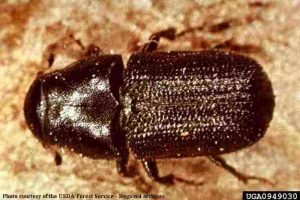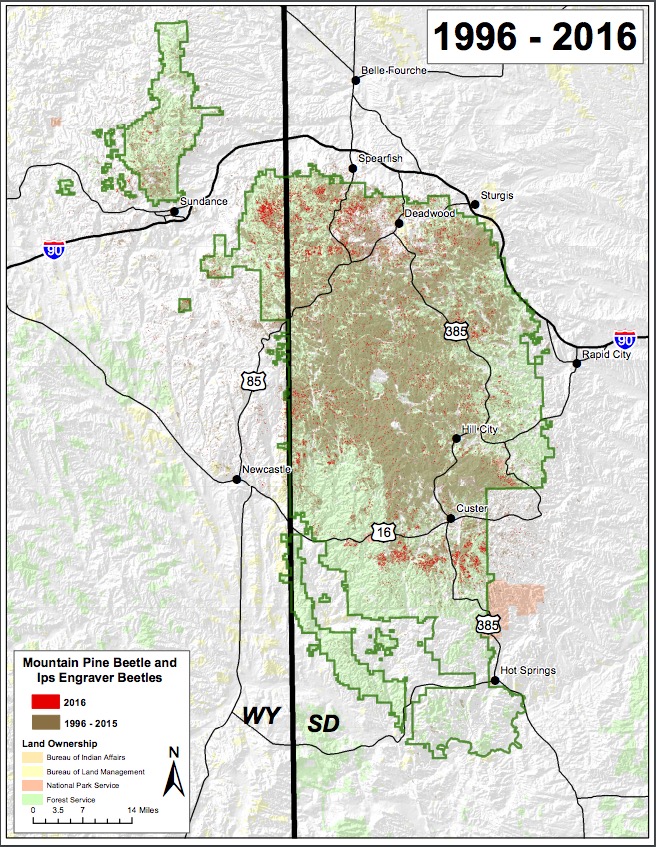
Just like San Francisco city employees and insurance execs, the mountain pine beetle is staying away from South Dakota. The beetle epidemic that turned much of the Black Hills brown over the past several years is apparently over:
Scott Jacobson, public affairs officer for the Black Hills National Forest, said there are some hot pockets of beetle activity, including near Deadwood, the northwest corner of the forest, and areas southeast of Custer, but overall the forest is in “good shape” [Mark Watson, “BH Nat. Forest: Pine Beetle Epidemic Is Over,” Black Hills Pioneer, 2017.04.01].
The U.S. Forest Service says, “Approximately 2,100 acres in the Black Hills N.F and vicinity experienced trees fading from mountain pine beetles and associated Ips engraver beetles, compared to 15,000 acres in 2015.”

In its press release accompanying the 2016 Forest Health Report, the Forest Service points out what we have noted here on the blog before, that the pine beetle is a natural part of the forest:
As a native species, the mountain pine beetle has always been a part of the Black Hills forest ecosystem, with periodic epidemics. The first recorded epidemic in the Black Hills occurred from the late 1890s through the early 1900s. Epidemics also occurred in the 1930s, 1940s, 1960s and 1970s, each lasting 8-13 years [USDA: Forest Service, press release, 2017.03.31].
Pine beetles likely came before those documented epidemics and gave Deadwood its name.
Nieman Timber’s Paul Pierson says the beetles took out a lot of trees that would have died anyway:
However, he pointed out areas that were too far infested to save, especially in the Central Hills, in the Deerfield Lake and Whitetail Peak areas.
“There is still green forest left behind there, but there are a lot of dead trees on the ground down there,” he said.
Pierson said those areas won’t return to the same condition in our lifetimes; however, it is important to remember that those stands were in an unhealthy state. “They were never going to last forever in an overstocked pine forest,” Pierson said [Watson, 2017.04.01].
We’ll see if Kristi Noem tries to take credit for the natural winding-down of the pine beetle epidemic as she campaigns for Black Hills votes next year.
Looking at photos of the Black Hills from the 1800s and the same locations in modern times, there are a lot more trees now than there were back then. Maybe this is an opportunity for the political parties to come together on an issue and agree that logging in the Black Hills is a good thing for both the economy and the environment.
This isn’t an issue for political parties to decide, Roschach. Politicians don’t have a clue how to manage forests. Forest management should be directed by scientist, taking into consideration input from the public. Scientists need to come up management plans that manage for the long-term health of all of the resources in the forest, not just pine trees destined for logging. Logging can be a management tool, but it can’t be the objective to maximize commercial logging at the expense of healthy forests.
Don, Trump has gotten rid of almost all scientists the government had left on the payroll, and indicates the rest will be gone soon. Who are they going to ask then? Logging companies will tell them how to do it, just like fossil fuel is advising them on the climate.
I wonder if this guy knows a pine beetle from a bottle of Pine Sol. Like Tim said, scientists under Drumpf are on the ESL and we all know what wingnuts think of endangered species.
If I mis-identified a hard working actual sci-bio he has my humblest opinion ever,
Let’s make that my humblest apology ever. It is Sunday afterall.
I was in the Hills at the start of the recent pine bark beetle outbreak. The logging companies were demanding increased logging was needed to log in order to limit the spread of the beetle. In reality the beetle just needed us to step out of the way, and it would manage the forest as it has done for millennia. A more natural fire regime would help.
Fire or logging. You prefer fire. I don’t wish that on anyone. I prefer logging of dead and dying trees and overgrown sections of forest. There are a lot of trees that can be harvested right now, no?
We can sit around wishing for a fire in the hills, or we can take a more active approach to management.
Rorsh: Science has long since proven that fire in a ponderosa pine forest is the best management tool available. Logging is not a substitute for fire and can’t be. The Black Hills Ponderosa Pine forest evolved with fire and logging, thinning, or even pine beetle epidemics can duplicate the effects of fire on the ground. Fire not only releases nutrients into the soil but also provides scarification for a diversity of understory seed that has remained dormant for nearly decades. Logging can’t even recreate the patchwork of overstory and plant diversity that is necessary for run off water purity and ground water recharge. After all that, we can begin to talk about wildlife habitat. Regardless of the dead or dying trees availability for logging, there is no market for bug killed trees! Some of that wood is being used to make novelty furniture but beyond that, the logging industry won’t bid it because there is no market. Furthermore, the industry won’t bid sales for that wood because it is too difficult to access. It might be a bit of a different story if there were a cadre of loggers with chain saws ready and able to climb steep, rocky slopes to cut, limb and size logs that one might, with great difficulty, get out to a log deck with the use of draft horses or old fashioned cable logging but all that tradition has been left in the dust. It’s all been replaced by timber harvester machines that don’t climb steep slopes real well. Bottom line is, all that dead and dying timber that is still standing does not increase the risk of catastrophic fire simply because all the needles have fallen off the trees where they contribute to sparse ladder fuels.
Everybody just calm down. The pine beetle simply heeding way to the this new President. That little insect shutters at its tiny little thought about this great big huge new American President. That’s all that’s happening right now.
But honestly, isn’t all that’s important what’s most beautiful and conducive for people to walk around in the Black Hills? No matter how thick or thin the Pinetree’s ever get, the rest of the Black Hills ecosystem is minimally changed. So just make it safe and pretty for people and then focus on everything else second. That’s where I’m at on the issue.